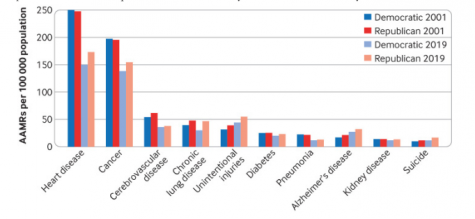Republican vs Democratic Mortality Rates
Bored out of my mind from a day of studying in my favorite coffee shop, I picked up a copy of The Gainesville Iguana and turned to a random page. I was shocked when I read the headline staring back at me: “People in Republican Counties Have Higher Death Rates Than Those in Democratic Counties.” And to think this article didn’t even make the main paper, it was in the News That “Didn’t Fit” section! Immediately, with my curiosity piqued, I looked up the article it was based off and got to researching.
The article, “Political environment and mortality rates in the United States, 2001-19: population based cross sectional analysis” was written by Haider J. Warraich, et. al. Dr. Warraich is a prolific author and doctor of internal medicine and cardiology training. He noticed that, while many United States’ death rates for different demographics (such as race, sex and ethnicity) have been compared, there has been very little research on the difference between death rates of Republican and Democratic counties. The counties were studied over different presidential periods, with their political classification based on who the majority of the population voted for.
Overall, the study found, adjusted for age, there was a greater mortality rate for Republican counties compared to Democratic counties, and this gap only continues to widen. For Democrats, the mortality rate decreased from 850.3 to 664 deaths per 100,000 people (22%), while for Republicans, it decreased from 867.0 to 771.1 deaths per 100,000 people (11%). The gap between counties in 2001 was only 16.7 deaths, however, by 2019, it was 107.1, showing an increase in mortality rates of more than six fold.

Now, what could cause this gap? The most obvious answer points to differences in policies. For example, Republican policies such as anti-abortion legislation can result in higher mortality rates for women, while Democratic policies such as stricter gun control could result in lower mortality rates. However, accidental deaths were only a small percentage of the mortality rates (3.3%). Policies that may have a greater impact on mortality rates have to do with access to healthcare and social welfare, which Democrats tend to support more. As Warraich states, “Democratic states were more likely than Republican states to adopt Medicaid expansion under the Affordable Care Act,” (Warraich, 14). Deaths due to physical health complications had the highest rates, for example, heart disease, cancer, and cerebrovascular disease, as shown below. These are things that, with access to healthcare, could increase your chances of survival. In fact, a study by Andrew P. Wilper and other doctors with the Department of Medicine at Cambridge Health Alliance found that 44,789 deaths a year resulted from lack of health insurance. This means that uninsured Americans have a “40 percent higher death risk than privately insured counterparts,” (Cecere). Additionally, while this study did not include Covid-19 deaths because it ended in 2019, policies such as mask requirements would also likely have an effect on mortality rate.

It is a scary time when your likelihood of death increases based on where you live, and even scarier when that is based on political values. As people realize that, along with the growing political divide, there is an accompanying mortality gap, hopefully we can look past who is voting for who and focus on what is best for our communities, and our health. For now though, I’d recommend moving quickly to the nearest Democratic county.
If you want to read more about the study, you can access it here: https://pubmed.ncbi.nlm.nih.gov/35672032/.
Bibliography
David Cecere, “New study finds 45,000 deaths annually linked to lack of health coverage.” Cambridge Health Alliance, 2009. https://news.harvard.edu/gazette/story/2009/09/new-study-finds-45000-deaths-annually-linked-to-lack-of-health-coverage/#:~:text=The%20study%2C%20conducted%20at%20Harvard,death%20rate%20found%20in%201993.
Warraich, Haider J et al. “Political environment and mortality rates in the United States, 2001-19: population based cross sectional analysis.” BMJ (Clinical research ed.) vol. 377 e069308. 7 Jun. 2022, doi:10.1136/bmj-2021-069308
Wilper, Andrew P et al. “Health insurance and mortality in US adults.” American journal of public health vol. 99,12 (2009): 2289-95. doi:10.2105/AJPH.2008.157685
Your donation will support the student journalists of Eastside High School. Your contribution will allow us to purchase equipment and cover our annual website hosting costs.

Kate Millinor is a writer for The Monthly Ram. She primarily writes articles detailing achievements of Eastside students. In her free time, Kate Millinor...



























